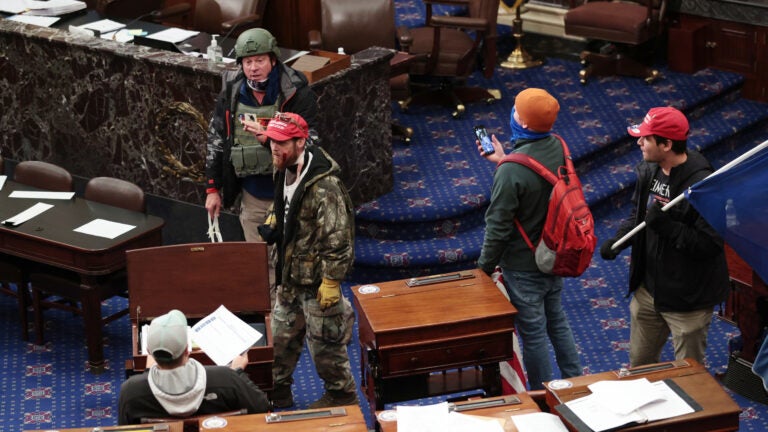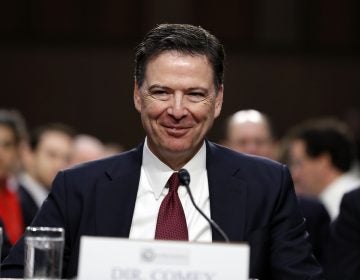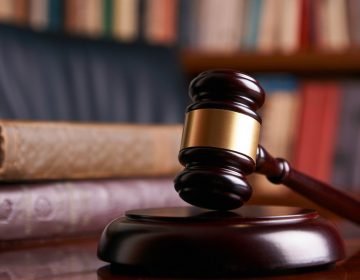Nearly 1 in 5 defendants in Capitol riot cases served in the military

Larry Rendall Brock Jr., an Air Force veteran, is seen inside the Senate Chamber wearing a military-style helmet and tactical vest during the rioting at the U.S. Capitol. Federal prosecutors have alleged that before the attack, Brock posted on Facebook about an impending "Second Civil War." (Win McNamee/Getty Images)
As a violent mob descended on the U.S. Capitol on Jan. 6, lawmakers and aides hid wherever they could, waiting for the military and police to arrive. But many of those who stormed the Capitol were military veterans themselves, who had once sworn to protect the Constitution. In fact, an NPR analysis has found that nearly 1 in 5 people charged over their alleged involvement in the attack on the U.S. Capitol appear to have a military history.
NPR compiled a list of individuals facing federal or District of Columbia charges in connection with the events of Jan. 6. Of more than 140 charged so far, a review of military records, social media accounts, court documents and news reports indicate at least 27 of those charged, or nearly 20%, have served or are currently serving in the U.S. military. To put that number in perspective, only about 7% of all American adults are military veterans, according to the U.S. Census Bureau.
Several veterans are charged with violent entry and disorderly conduct on Capitol grounds. One of them is Larry Rendall Brock Jr. The Air Force veteran was photographed in a military-style helmet and tactical vest carrying flex cuffs inside the Capitol. He posted on Facebook that he was preparing for a “Second Civil War,” according to documents filed in federal court. In the weeks after Biden’s victory, Brock posted that “we are now under occupation by a hostile governing force.”
“I see no distinction between a group of Americans seizing power and governing with complete disregard to the Constitution and an invading force of Chinese communists accomplishing the same objective,” Brock wrote. (There is no credible evidence of widespread voter fraud in the 2020 election.) He ended his post with a reference to the oath taken by members of the military: “Against all enemies foreign and domestic.”
Some veterans who allegedly stormed the Capitol are still serving in some capacity. Jacob Fracker, 29, was an infantry rifleman in the Marine Corps and deployed to Afghanistan twice, according to the Pentagon. He now serves in the Virginia National Guard, according to widespread news reports, though he was not among the service members deployed to Washington ahead of the inauguration. He is also a police officer in Rocky Mount, Va. With him at the Capitol on Jan. 6 was his colleague from the Rocky Mount Police Department, Thomas Robertson, 47, who is an Army veteran also facing charges.
Federal prosecutors have also alleged that multiple members of the right-wing extremist group the Oath Keepers took part in the “incursion” at the Capitol. The group has been known to target and recruit active-duty members of the military and veterans, in part for their specialized skills. Among those charged in relation to the storming of the Capitol are Thomas Edward Caldwell, a Navy veteran and alleged leader among the Oath Keepers, and Donovan Ray Crowl, a Marine Corps veteran. They have been charged with conspiracy to obstruct the Electoral College vote, among other alleged crimes.
Attorneys representing those facing charges did not respond to NPR’s messages seeking comment.
Rooting out extremism
Roughly one-third of active duty troops said they had “personally witnessed examples of white nationalism or ideological-driven racism within the ranks in recent months,” according to a 2019 survey conducted by the Military Times and Syracuse University Institute for Veterans and Military Families. Troops said they had seen “swastikas being drawn on service members’ cars, tattoos affiliated with white supremacist groups, stickers supporting the Ku Klux Klan and Nazi-style salutes between individuals.”
At least one individual charged in connection with the assault on the Capitol allegedly embraced that extremist ideology. Timothy Louis Hale-Cusanelli, 30, is a Navy contractor who has worked at a naval weapons station with a secret security clearance, according to court documents. He is also an Army Reserve sergeant in the 174th Infantry Brigade and an “avowed white supremacist and Nazi sympathizer,” according to court documents.
Some experts argue the military has not done enough to tamp down on extremism in its ranks.
Mark Pitcavage, a senior research fellow with the Anti-Defamation League’s Center on Extremism, called the military’s efforts largely “haphazard.”

“It’s not like the military is just tolerating white supremacists,” Pitcavage told NPR. But he said efforts to address the problem need to be more systematic.
“Not only does there need to be training,” Pitcavage said, “but there also need to be clear expectations coming down from on high about what you should do when you encounter an extremist in your unit, at your base or whatever the circumstances are, and that here are the procedures that need to be followed.”
The problem is not entirely lost on the Defense Department. After the Jan. 6 insurrection, a senior defense official told NPR there were 68 notifications of investigations by the FBI last year of former and current military members pertaining to domestic extremism.
When extremism in the military does go undetected or ignored, the stakes can be high.
As Heidi Beirich, co-founder of the Global Project Against Hate and Extremism, testified to Congress, veterans and military personnel “have training that makes terrorist attacks more achievable and more deadly.”
In 2019, federal prosecutors said that Coast Guard Lt. Christopher Hasson had planned a series of violent attacks against liberal politicians, and was an avowed white nationalist for decades. Hasson ultimately pleaded guilty to drug and weapons charges.
Timothy McVeigh, who carried out the 1995 Oklahoma City bombing that killed 168 people, was an Army veteran who served in the Persian Gulf War. He had taken inspiration from the white supremacist novel “The Turner Diaries,” which continues to hold sway among far-right extremists.
Pitcavage cautions that there is limited evidence military veterans are more susceptible to extremist ideology than any other group of Americans.
“Overall, our veteran population is largely reflective of our general population,” Pitcavage said.
Veterans, for example, have also been on the front lines of the fight against extremism. Brian Sicknick, the police officer who died trying to prevent the mob from storming the Capitol, was also a veteran.
The New Jersey Air National Guard, where Sicknick served, said, “Staff Sgt. Sicknick’s commitment to service and to protect his community, state, and nation will never be forgotten.”
In his inaugural address on Wednesday, President Biden pledged to combat “a rise of political extremism, white supremacy, domestic terrorism.”
Likewise, Biden’s pick to lead the Department of Defense, retired Gen. Lloyd Austin, told Congress on Tuesday that, if confirmed, he would work to combat extremism in the military, a problem the Defense Department acknowledged in a report in December.
Austin, who would be the nation’s first Black defense secretary, said he would fight hard “to rid our ranks of racists.”
“The Defense Department’s job is to keep America safe from our enemies,” he testified. “But we can’t do that if some of those enemies lie within our own ranks.”
9(MDAzMzI1ODY3MDEyMzkzOTE3NjIxNDg3MQ001))



